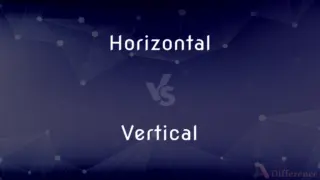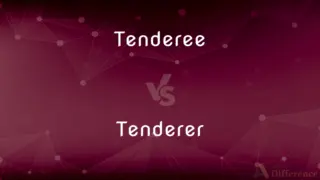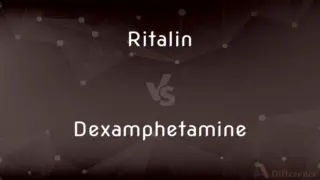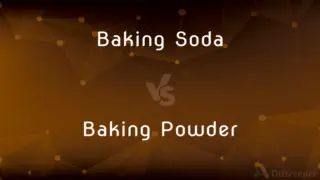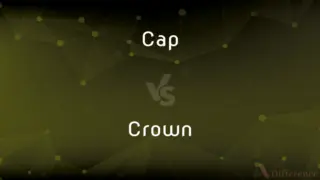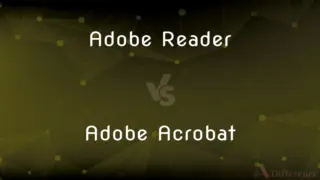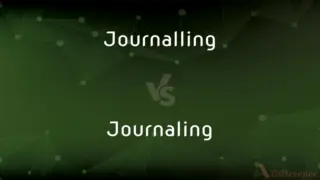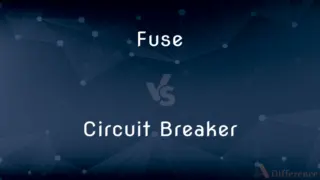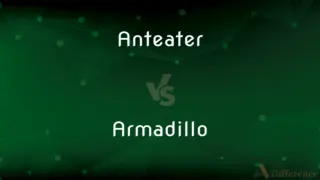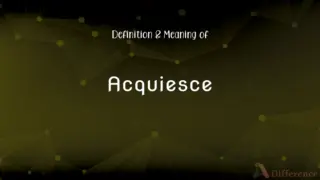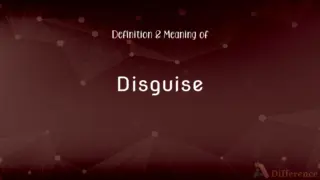Inductance vs. Inductor — What's the Difference?
By Fiza Rafique & Maham Liaqat — Updated on March 29, 2024
Inductance is the property of an electrical conductor by which a change in current induces an electromotive force, while an inductor is a device that exploits this property, typically a coil of wire.

Difference Between Inductance and Inductor
Table of Contents
ADVERTISEMENT
Key Differences
Inductance is a fundamental electrical property that quantifies the ability of an electrical conductor to induce an electromotive force when there is a change in current flowing through it. This concept is crucial in understanding how circuits resist changes in current. On the other hand, an inductor is a physical device, often in the form of a coil, designed to take advantage of the principle of inductance. It stores energy in a magnetic field when electric current flows through it.
While inductance is a measure (in henrys, H) that applies to any conductor, showing its tendency to oppose changes in current, an inductor specifically refers to a component manufactured to have a certain amount of inductance. Inductors are used in a variety of applications, such as filtering and energy storage in power supplies.
The inductance of a conductor depends on its physical dimensions, the number of turns in the coil, and the core material, which could be air or magnetic material. In contrast, an inductor is characterized not just by its inductance value but also by its current-carrying capacity, resistance, and potential to dissipate heat.
Inductance is an intrinsic property that can be observed in any conductive path, including simple wires or complex coil arrangements. Whereas inductors are intentionally designed to introduce a specific amount of inductance into a circuit, with designs optimized for minimal resistance and maximal efficiency.
The calculation of inductance involves understanding the magnetic flux linkage with the current flowing through the conductor. Conversely, when selecting an inductor for a circuit, engineers consider factors like the desired inductance, the current it needs to carry, and the frequency of operation, among others.
ADVERTISEMENT
Comparison Chart
Definition
Property of a conductor that induces an EMF due to a change in current
A device designed to have a specific inductance
Measurement Unit
Henry (H)
Henry (H), but also specified by current capacity and resistance
Physical Form
Abstract property, no physical form
Often a coil of wire around a core
Application in Circuits
Describes how a circuit element behaves
Used to control current flow, filter signals, store energy
Core Material Influence
Depends on material for its value
Choice of core material affects efficiency, inductance, and application
Compare with Definitions
Inductance
The principle of inductance is applied in transformers.
Transformers work by transferring energy through inductance.
Inductor
Inductors resist sudden changes in current flow.
Inductors in power supplies prevent spikes during power fluctuations.
Inductance
Inductance can cause transient responses in switching circuits.
Surge protectors mitigate the effects of inductance in circuits.
Inductor
An inductor is a component that adds inductance to a circuit.
Adding an inductor in series can smooth out ripple currents.
Inductance
It's the reason an EMF is induced in a conductor when the current changes.
High inductance in power lines can cause voltage drops.
Inductor
It's typically a coil of wire that generates a magnetic field.
The inductor's magnetic field stores energy from the current.
Inductance
Inductance values affect the performance of AC circuits.
Calculating the circuit's inductance helps in designing efficient filters.
Inductor
Inductors are used in filters, transformers, and storage devices.
In RF circuits, inductors filter out unwanted frequencies.
Inductance
Inductance measures a conductor's opposition to changes in current flow.
The inductance of the coil increases with more turns of wire.
Inductor
The inductance of an inductor depends on its coil turns and core material.
Ferrite cores in inductors help in achieving high inductance.
Inductance
Inductance is the tendency of an electrical conductor to oppose a change in the electric current flowing through it. The flow of electric current creates a magnetic field around the conductor.
Inductor
An inductor, also called a coil, choke, or reactor, is a passive two-terminal electrical component that stores energy in a magnetic field when electric current flows through it. An inductor typically consists of an insulated wire wound into a coil.
Inductance
The property of an electric circuit by which an electromotive force is induced in it as the result of a changing magnetic flux.
Inductor
A device that functions by or introduces inductance into an electric circuit.
Inductance
A circuit element, typically a conducting coil, in which electromotive force is generated by electromagnetic induction.
Inductor
The chemical reactant that initiates or accelerates an induced reaction and is consumed in the process.
Inductance
(physics) The property of an electric circuit by which a voltage is induced in it by a changing magnetic field.
The power cable itself has enough inductance to disrupt the digital signal of the video output cable, due to poor shielding.
Inductor
(electronics) A passive device that introduces inductance into an electrical circuit.
Inductance
The quantity of the resulting electromagnetic flux divided by the current that produces it, measured in henries (SI symbol: H.)
What is the inductance of that power supply's main inductor?
Inductor
(medicine) an evocator or an organizer
Inductance
Capacity for induction; the coefficient of self-induction.
Inductor
The person who inducts another into an office or benefice.
Inductance
(physics) a property of an electric circuit by which an electromotive force is induced in it by a variation of current
Inductor
That portion of an electrical apparatus, in which is the inducing charge or current.
Inductance
An electrical device that introduces inductance into a circuit
Inductor
An electrical device that introduces inductance into a circuit
Common Curiosities
What is inductance?
Inductance is the property of an electrical conductor that quantifies its ability to induce an electromotive force as a result of a change in current flowing through it.
Can inductance occur in any conductor?
Yes, inductance is a property that can occur in any conductor, depending on its shape, size, and the current flowing through it.
What is an inductor?
An inductor is a passive electrical component designed to introduce inductance into a circuit, typically consisting of a wire coil.
How is inductance measured?
Inductance is measured in henrys (H), indicating the level of opposition to changes in current flow.
Why are inductors used in circuits?
Inductors are used in circuits for energy storage, filtering signals, and managing current flow, among other applications.
What is the relationship between inductance and frequency?
Inductance affects the impedance of a circuit in a frequency-dependent manner, with higher inductance causing greater opposition to AC at higher frequencies.
What are some common uses of inductors?
Inductors are commonly used in power supplies, signal filtering, and energy storage applications.
How do you increase an inductor's inductance?
Increasing the number of turns in the coil or using a core with higher magnetic permeability can increase an inductor's inductance.
What is the difference between inductance and resistance?
Inductance opposes changes in current flow due to a changing magnetic field, while resistance opposes current flow due to the material's properties.
Do inductors consume power?
Inductors do not consume power; they store energy in a magnetic field, which can be released back into the circuit.
What affects the inductance of a conductor?
The inductance of a conductor is affected by its physical dimensions, the number of turns in the coil, and the core material.
How are inductors manufactured?
Inductors are manufactured by winding a conducting wire, such as copper, around a core material, which can be air or a magnetic substance.
Can inductance be negative?
In typical passive components, inductance is positive, representing energy storage in a magnetic field. Negative inductance can be simulated in certain active circuits.
How does core material affect an inductor's performance?
The core material affects an inductor's performance by influencing its inductance, efficiency, and operational frequency range.
What happens when an inductor is removed from a circuit?
Removing an inductor from a circuit can alter the circuit's overall inductance, potentially affecting current flow, signal filtering, and energy storage capabilities.
Share Your Discovery

Previous Comparison
Polytope vs. Polyhedron
Next Comparison
Aircraft vs. AirshipAuthor Spotlight
Written by
Fiza RafiqueFiza Rafique is a skilled content writer at AskDifference.com, where she meticulously refines and enhances written pieces. Drawing from her vast editorial expertise, Fiza ensures clarity, accuracy, and precision in every article. Passionate about language, she continually seeks to elevate the quality of content for readers worldwide.
Co-written by
Maham Liaqat
